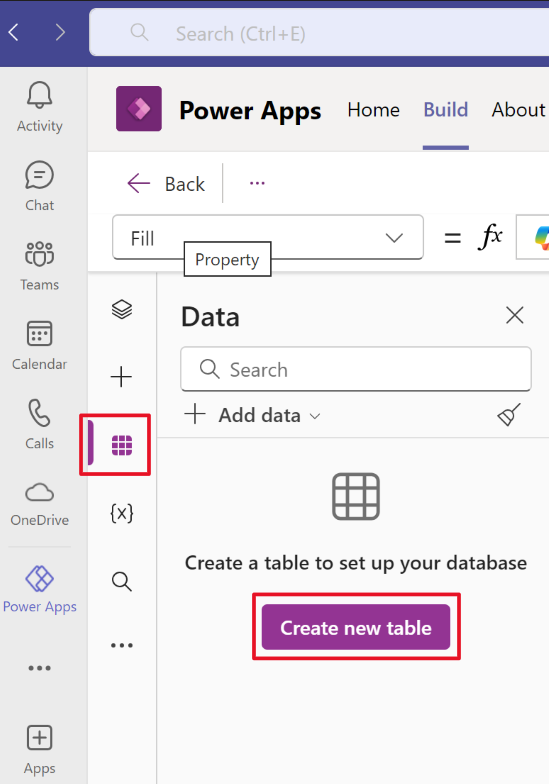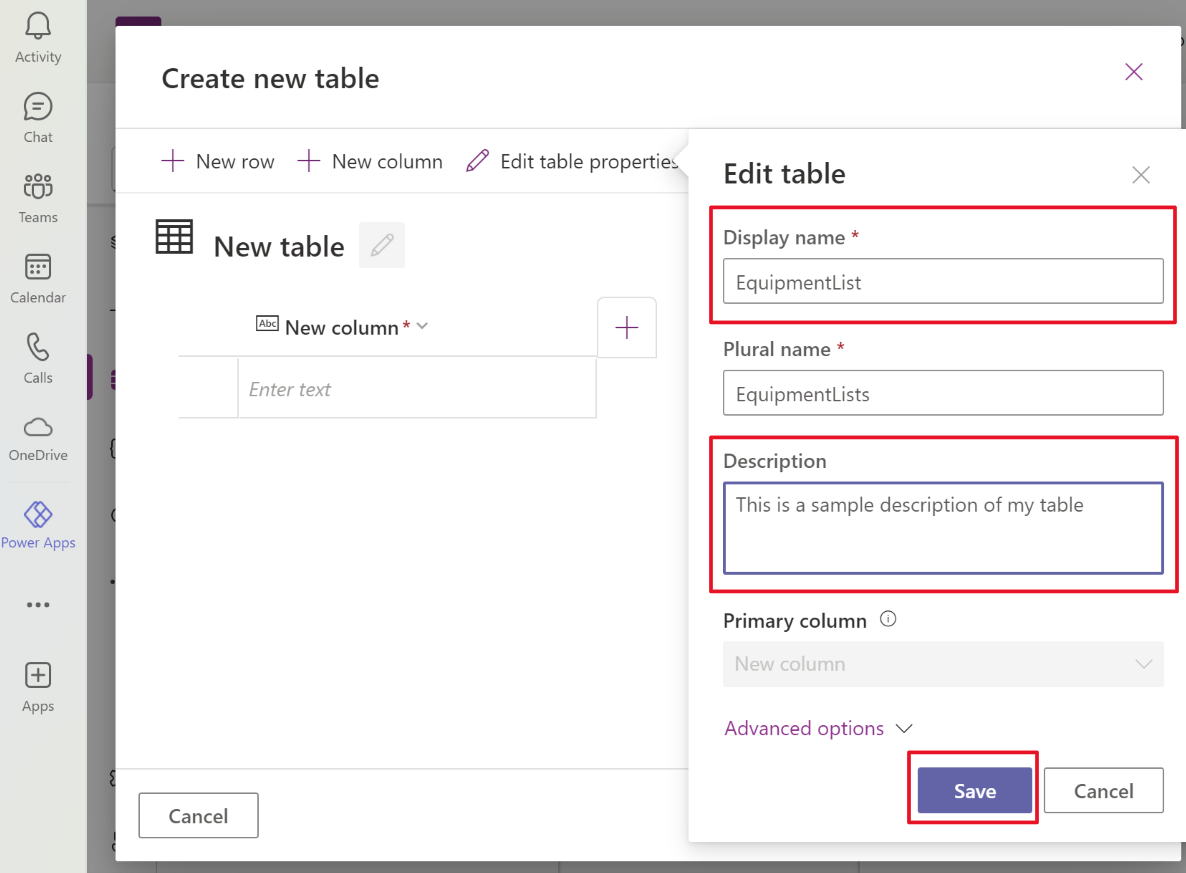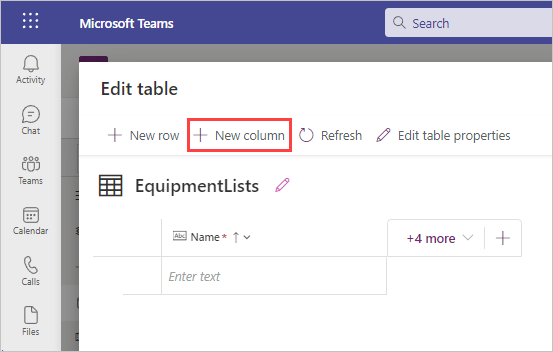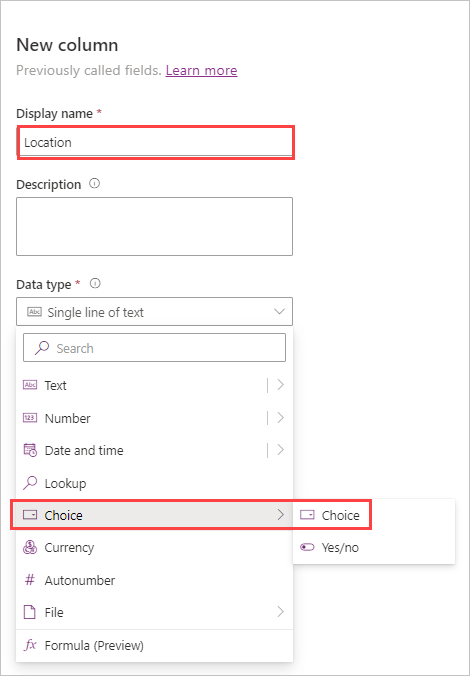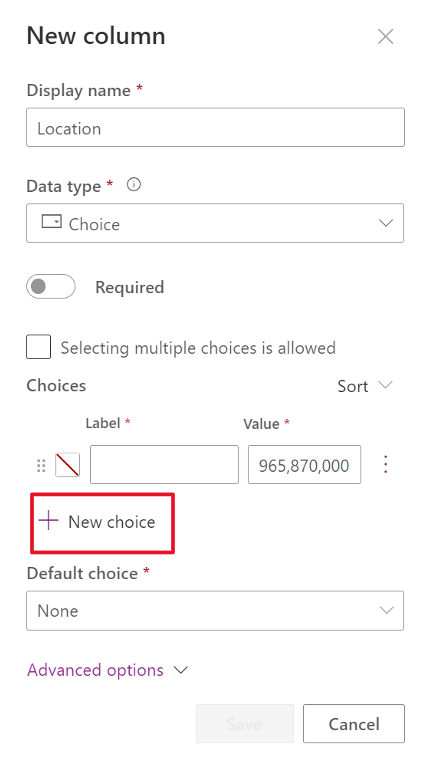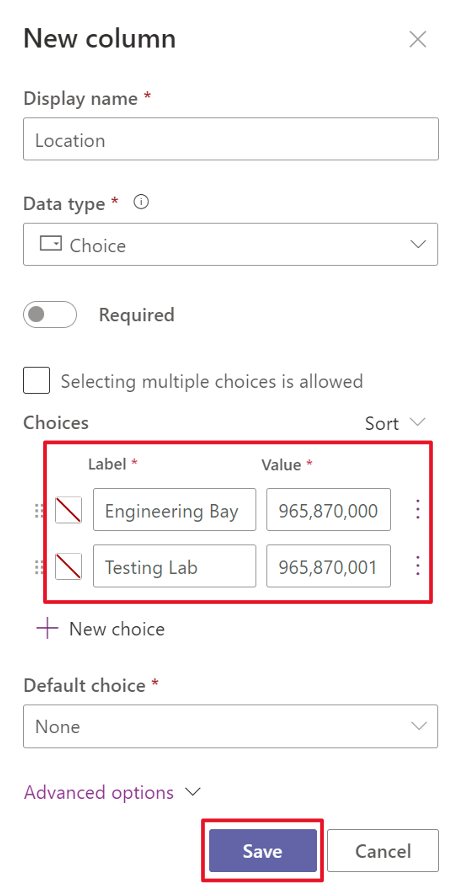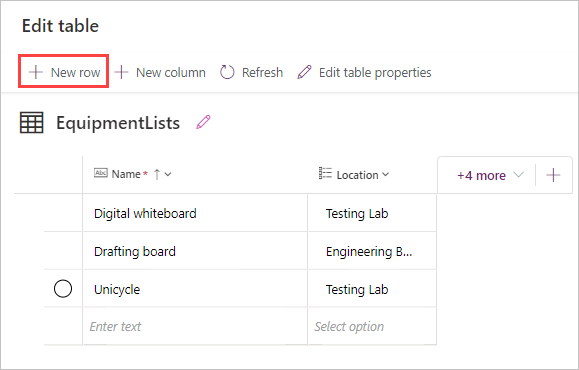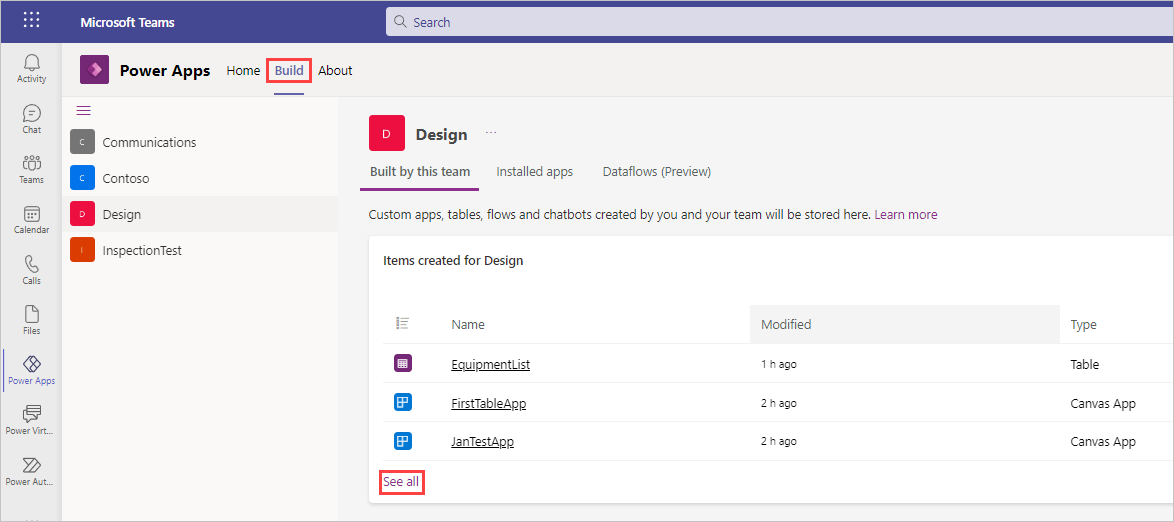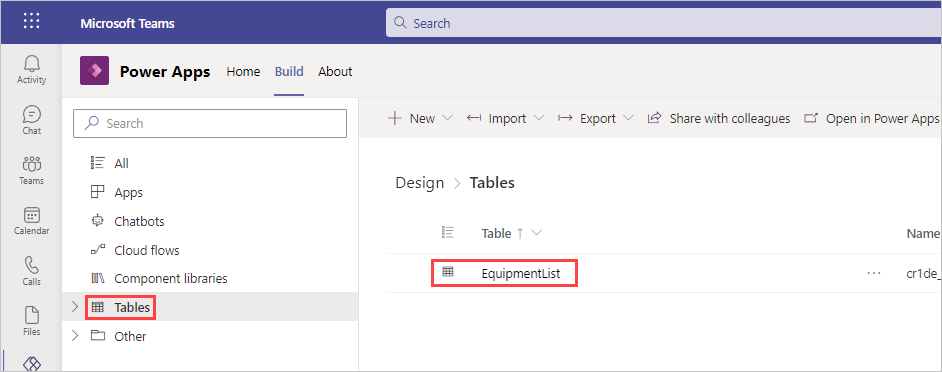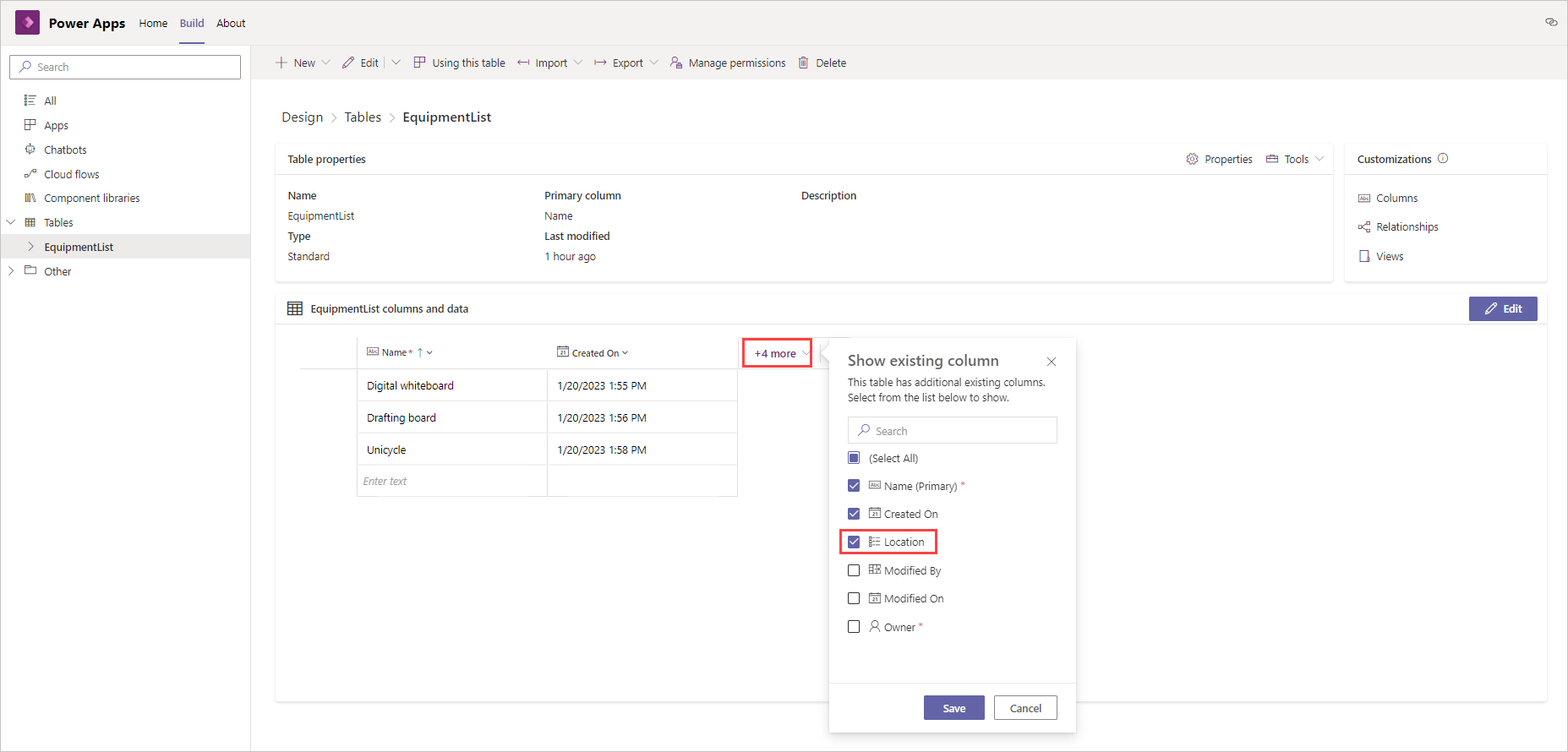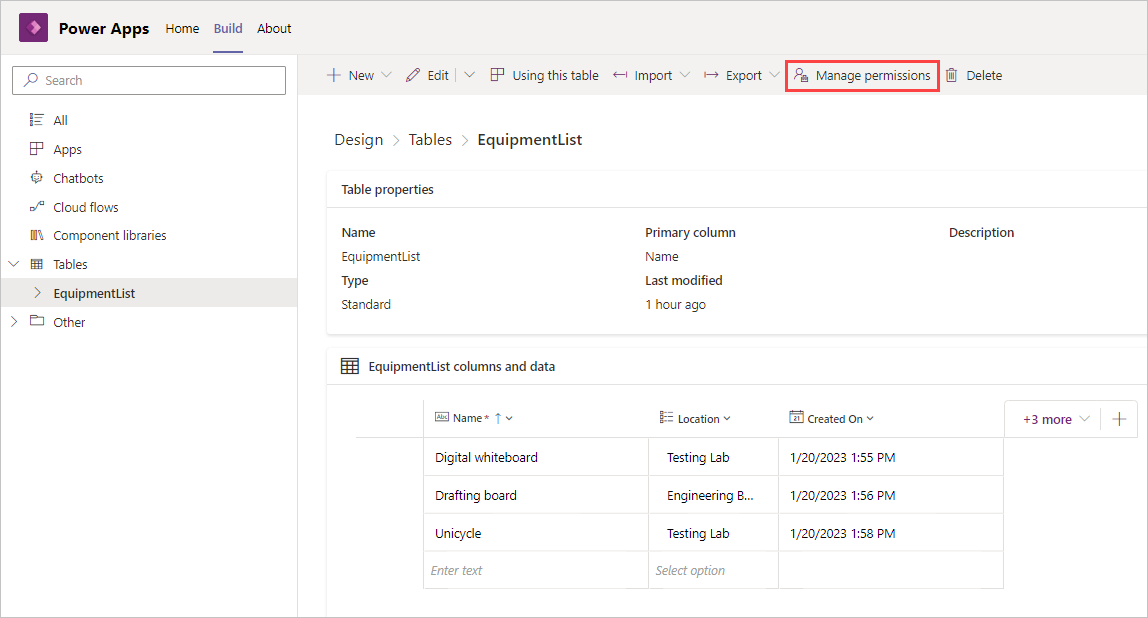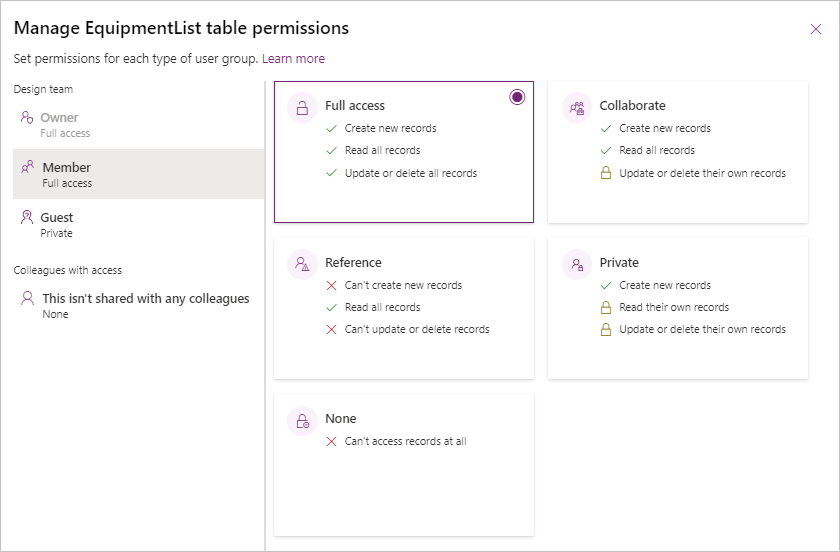Create your first table to store data
Now that you've provisioned a Dataverse for Teams environment for your selected team, you can begin creating solutions. Power Apps, Power Automate flows, and chatbots are ineffective without data to drive them, so your first step is to create a table in your environment to store your data.
Power Apps visual table editor
To access the Power Apps visual table editor, follow these steps:
While editing an app in the Power Apps editor for Teams, select the data button from the Power Apps side rail and then select the Create new table button.
Select Start with a blank table. After a few seconds, your table will be provisioned and will display in the visual table editor. Select Edit table properties. Enter EquipmentList in the Display name field because your table will be a list of equipment. Enter a Description and click Save.
The visual table editor enables you to quickly populate your table with the + New row and + New Column options.
You'll use this Edit table editor to populate some data into your table. The following steps show how to add a Location column that will have two choices: Engineering Bay and Testing Lab.
Select + New column from the header ribbon.
A New column pane will appear on the right side of your screen. In the Display name column, enter:
LocationTo indicate the type of data that the table will contain, Under Data type select Choice > Choice.
Now, define the choices for this column by selecting + New choice under Choices.
Once you have two rows to enter your choices, enter the Label for each of your choices:
Engineering BayandTesting Lab. Then select Save. (Note that the Value will be auto-assigned; your values will be different than the displayed values in this example.)From the table editor, you can use any of the following data types.
Data type Description Text Includes single and multiple lines of plain text, rich text, email, phone number, ticker symbol and URL Number Includes whole number, decimal, float, language code, duration and time zone Date and Time Includes Date and time, or Date only options Lookup References a primary column in another table Choice Allows people to select a choice from a list, also includes Yes/No choice options Currency Column behavior and formatting are set to replicate currency Autonumber Defines an autogenerated number sequence File Allows you to place an image or file in the column Formula A preview feature that allows input of an fx formula into the column Next, let's add some data to our list. Select + New row to add several rows to your table with data.
After you have finished editing the table, select Save and close from the bottom right corner of the editor to return to the app. Now that you have data, you can begin building your app.
Power Apps table editor
Occasionally, you'll want to edit your table from the table editor. Though the available column types are identical, the table editor enables you to define Relationships and Views for your data.
To open your table in the table editor, select Build and then See all.
Your display will show all of the available apps, flows, and tables available for this Team. Select Tables and then select the table you want to edit. Simply selecting the table brings up the table editor.
In the table editor you can add columns and data to your table via the columns and data pane at the bottom of the screen. Take a moment to look at the other columns, which have been created with your table by selecting the +N more button (where "N" is an integer). You'll see checks placed by the columns that are currently displayed and some others that you could display by selecting the checkbox next to the column name. For the EquipmentList table we created, let's select our Location column and then Save.
Now you should see your Location column displayed in your table.
The table editor also allows you to drag and drop columns to reorder them. Select your Location column and drag it to the left of the Created On column so that your list looks similar to this:
Management interface overview
Now that you've provisioned your environment and created a table with columns, you can create administrative settings for your table. Dataverse for Teams includes a management interface for the team owner to do this. Team members can't change the permissions.
While editing your table within Power Apps Build, select Manage Permissions from the ribbon menu. This option doesn't appear if you aren't a team owner.
The Manage permissions pane appears on the right side of your screen. Here, you can define different access levels to your table and its data. Different privilege levels are available for the team members and colleagues who have this table shared with them.
Five different permission options include:
Full access - Allows users and groups full access to create new records, read all records, and update or delete records. This level of access should only be granted to users who need full control over the data.
Collaborate - Allows the creation of new records and the ability to read existing records, but it denies the ability to update existing records or delete them unless they were created by the user. This level of privilege is beneficial for typical users who shouldn't have administrative level access over the data that they're connecting with, but who still need the ability to create new records in the table and edit or delete records that they previously created. This level of privilege is the most commonly assigned for most use cases.
Reference - Allows the assigned user or group the ability to read all records from the table but not to interact with the data in any other way. This level of privilege is useful for look-up tables where an administrator defines the data, while other users should only be able to read from the data as a reference for their work, for example.
Private - A unique privilege level that allows users or groups to create new records in the table (which Reference doesn't) but doesn't allow users or groups to read records that weren't created by them. It also allows the user or group to update and delete their own records but not records that were created by other users. This level of privilege is best used in situations where sensitive information is held within the table that shouldn't be exposed to typical users.
None - Denies access entirely; the user or group can't view or modify records within the table, and they can't delete them.
Each privilege level can be assigned to either users or groups, depending on your requirements. It isn't uncommon to add guest users to a team, and those users might need to have a different level of access than internal organization's users. For this reason, Manage table permissions will allow you to manage members separately from guests.
Try selecting one of the Design team categories (or users/groups under the Colleagues with access section, if available) and changing the level of access. If your team has multiple owners, the Owners option will be visible, and you can define access for those users as well. In the preceding screenshot, members of the team have been granted Full access. With any changes you make, select Save to continue.
Congratulations, you've now successfully created a data table in Dataverse for Teams, added columns to your table, used the table editor, and managed the table permissions. Let's do a quick knowledge check to confirm what you've learned.
